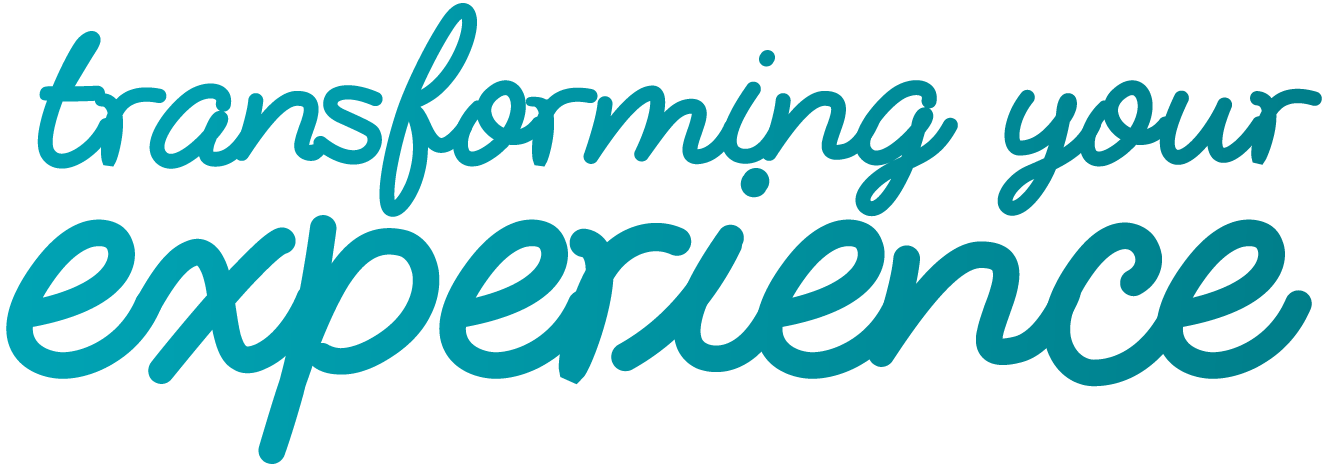Close the Gap
Improving Food Security within the Aboriginal Community
What is food security?
Food security exists "when all people, at all times, have physical and economic access to sufficient, safe and nutritious food to meet their dietary needs and food preferences for an active and healthy life" 1
What is food insecurity?
Food insecurity refers to not having sufficient food; experiencing hunger as a result of running out of food and not being able to afford more; eating a poor quality diet as a result of limited food options; anxiety about acquiring food; or having to rely on food relief (NSW Centre for Public Health, 2003).
Aboriginal people are at higher risk of food insecurity than non-indigenous Australians. To ensure food security we need to address:
- Food access: having sufficient resources to obtain appropriate nutritious foods
- Food availability: sufficient quantities of food available reliably
- Food use: appropriate use based on knowledge of nutrition, as well as adequate infrastructure (World Health Organisation).
Tharawal Koori Community Kitchen
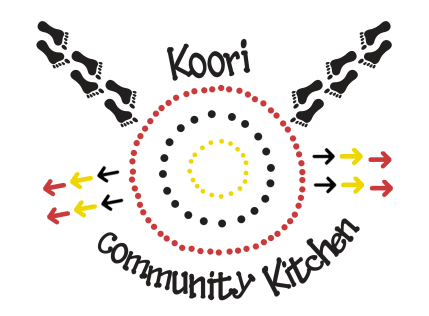
The Koori Community Kitchen project was set up to reduce the factors associated with food insecurity amongst Aboriginal families in Airds, NSW. A partnership between Tharawal Aboriginal Corporation and the Health Promotion Service, South Western Sydney Local Health District, identified the issue and worked together with the community on this project.
A Community Kitchen is a place to meet friends, have a yarn, cook healthy, nutritious meals together and connect with the community. Nutrition is a big part of each Community Kitchen along with a chance to try new recipes and new foods which can help achieve a healthy diet and better health in the future.
It is also a place to share ideas on feeding a family and keeping costs down.
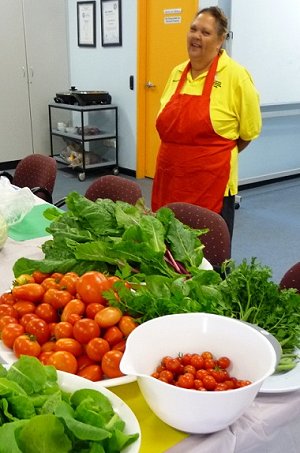
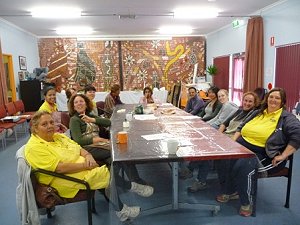
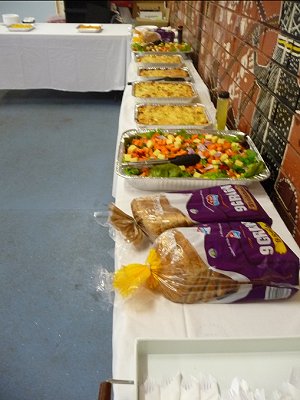
Tharawal Healthy Food Policy and Recipe Book
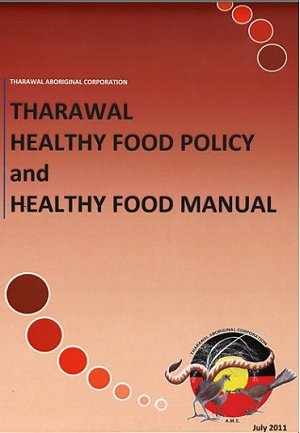 The Koori Community Kitchen has highlighted and generated interest in healthy eating, nutrition and cooking. Tharawal now has a healthy food policy which aims to promote good nutrition across its community by providing healthy and nutritious foods and drinks to staff, the community and guests.
The Koori Community Kitchen has highlighted and generated interest in healthy eating, nutrition and cooking. Tharawal now has a healthy food policy which aims to promote good nutrition across its community by providing healthy and nutritious foods and drinks to staff, the community and guests.
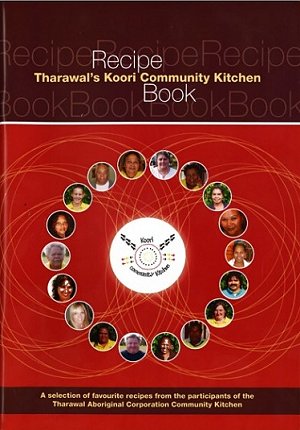 The Tharawal Aboriginal Corporation is one of the few services to have a healthy food policy. The policy was developed through the partnership between Tharawal and the Health Promotion Service. The aim of the policy is to promote good nutrition across the Tharawal community and provide direction on what type of food and drink should be provided at events and functions.
The Tharawal Aboriginal Corporation is one of the few services to have a healthy food policy. The policy was developed through the partnership between Tharawal and the Health Promotion Service. The aim of the policy is to promote good nutrition across the Tharawal community and provide direction on what type of food and drink should be provided at events and functions.
The Good Tucker All Round
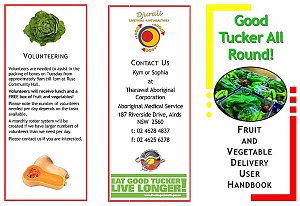 'The Good Tucker All Round' fruit and vegetable delivery program deliver boxes of fresh fruit and vegetables to Aboriginal and Torres Strait Islander people living in the region.
'The Good Tucker All Round' fruit and vegetable delivery program deliver boxes of fresh fruit and vegetables to Aboriginal and Torres Strait Islander people living in the region.
The aims of the program are:
- Increase understanding of the importance of eating nutritious food to help prevent chronic disease
- Increase uptake of health services and health checks
- Decrease consumption of foods which are high in fat, sugar, and salt and increase fruit and vegetable consumption
- Improved management of chronic disease.
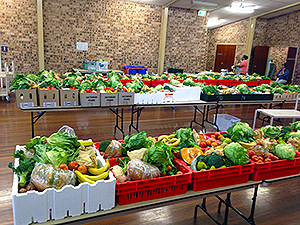
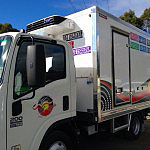
The Good Tucker program purchases good quality fruit and vegetables in bulk at the Flemington markets. Staff oversee the packing of the produce by volunteers into individual boxes. Families pay $15 for substantially larger quantities of fruit and vegetables than would be able to be purchased at a local supermarket. Boxes are delivered to
Supermarket Basket $15 |
Good Tucker Basket $15 |
|
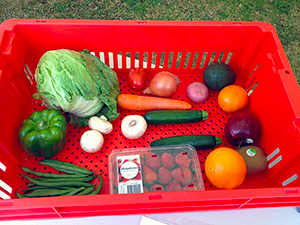 |
This comparison shows what was purchased for $15 at the local supermarket and what is in the 'Good Tucker All Round box' |
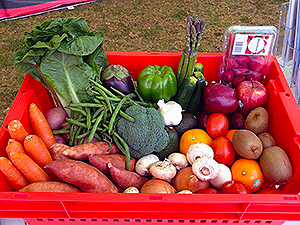 |
Community Garden
Tharawal has provided land, which has enabled the Community Kitchen program to expand to include a Community Garden. The garden has run workshops that teach the skills needed to grow fruit and vegetables. The vegetables and herbs grown fresh from the garden are used in the Community Kitchen.
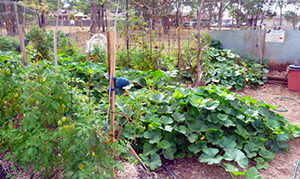
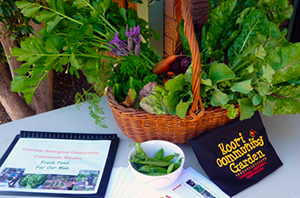
Further Information
Contact: Alice Wood on 02 4640 3535 or email Alice.Wood@sswahs.nsw.gov.au
- Food and Agriculture Organization of the United Nations (FAO) 2005
- United Nations, 1948. The Universal Declaration of Human Rights. http://www.un.org/Overview/rights.html
- Food Security for Aboriginal and Torres Strait Islander Peoples Policy 2008 (joint policy of the Dietitians Association of Australia (DAA) and the Public Health Association of Australia (PHAA)
- Acting on food insecurity in urban Aboriginal and Torres Strait Islander communities. Browne et al, VACCHO, 2009
- ABS 2010 http://www.abs.gov.au/AUSSTATS/abs@.nsf/lookup/4704.0Chapter218Oct+2010
Close the Gap
Chronic disease prevention in the Aboriginal community
It is estimated that chronic diseases are responsible for 80% of the mortality gap between Aboriginal and other Australians aged 35 - 74 years. Aboriginal Australians are three times more likely to develop chronic conditions and 64% are overweight when compared to 51% of non-Aboriginal Australians. It is well documented that these chronic conditions can be prevented through dietary modification and physical activity participation.
Lyrebird Exercise Groups
Lyrebird exercise classes were established to provide an opportunity for Aboriginal people who were not accessing mainstream physical activity services in the Macarthur area to meet physical activity guidelines. A coordinated program of exercise classes was developed through existing partnerships between Tharawal Aboriginal Corporation (TAC), Health Promotion Service, SWSLHD (HPS) and the local Aboriginal community.
The first exercise class was established in November 2010 in the Macarthur area, with two more exercise classes added in 2011. All three exercise classes are still running weekly during school terms.
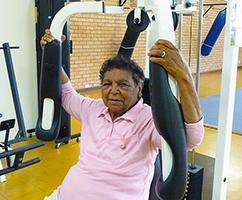
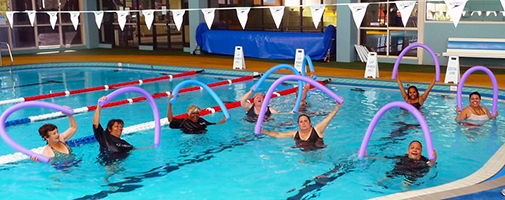
Family Diabetes Program
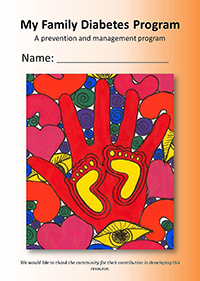 The Family Diabetes program educates and supports Aboriginal people and their families to prevent or manage their diabetes. The 12 month program was trialled in April 2012 to March 2013 and ran again in May 2013 to April 2014.
The Family Diabetes program educates and supports Aboriginal people and their families to prevent or manage their diabetes. The 12 month program was trialled in April 2012 to March 2013 and ran again in May 2013 to April 2014.
Materials and resources including a Diabetes Resource Manual were developed in partnership with the Aboriginal Community and Tharawal Aboriginal Corporation (TAC). Topics include - developing a Healthy Lifestyle, Managing Stress and making Healthy Choices.
"Feeling Alive and Looking Deadly" DVD
In 2012, Campbelltown City Council, Tharawal Aboriginal Corporation, Short Black Films and the Health Promotion Service produced an exercise DVD, "Feeling Alive and Looking Deadly" to encourage community members to exercise at home. Feeling Alive and Looking Deadly was filmed with members of the Aboriginal community. It demonstrates how to exercise at home with everyday items and includes a three level strength program, cardiovascular exercise and other useful information.
Elders Olympics
The Elders Olympics runs every year in March for elders in the community from Macarthur, Camden, Wollondilly and Wingecarribee areas. Established in 2012, the event aims to attract 7-10 teams from the area which are made up of 10 men and women. The event is coordinated by a number of local organisations including Macarthur Disability Service, Sport and Recreation, Tharawal Aboriginal Corporation, Tharawal Local Aboriginal Land Council, Muru Nanga Mai and local government.
The Elders Olympics has proved a popular way to engage elders who are not physically active in low intensity exercise. The Elders Olympics consists of five team activities which include:
- Walking relay - participants can walk, be pushed by wheelchair, use the walking frames to move the baton on every 5 metres
- Quoits - participants throw light rings at a ring 1 metre away
- Bean bag throw - participants throw bean bags at a target 1 metre away
- Gorri (Traditional Indigenous Game) - participants throw a tennis ball at a moving target 5 metres away
- Tunnel ball - participants pass the ball around their side or over their heads to the next team member.
Further information
Contact Alice Wood on 02 4640 3535 or email Alice.Wood@sswahs.nsw.gov.au
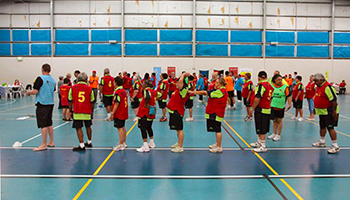
Close the Gap
Aboriginal Tobacco Control Project
Why do we need an Aboriginal Tobacco Control Project?
The smoking rate of Aboriginal and Torres Strait Islander adults who are current daily smokers is more than double the rate than in the non- Aboriginal population. Tobacco use is a major preventable contributor to the gap in life expectancy1 & 2. Community ownership and flexibility of tobacco control interventions has been recognised as vital to enable Aboriginal and Torres Strait Islander communities to develop initiatives appropriate to their needs.3 & 4
Addressing the smoking rates of Aboriginal and Torres Strait Islanders is identified as a priority in the NSW 2021 Plan and NSW Tobacco Strategy 2012-2017.
In response to high smoking rates, a partnership project was established to develop a culturally appropriate tobacco control project for the Aboriginal and Torres Strait Islander community residing in south west Sydney.
The Aboriginal Tobacco Control Project aims to reduce smoking prevalence in the Aboriginal and Torres Strait Islander population residing in south west Sydney by 5 per cent.
The project partnership involves three Aboriginal Community Controlled Organisations:
- Aboriginal Medical Service Redfern (AMS)
- Tharawal Aboriginal Corporation (TAC)
- Babana Aboriginal Men's Group
With support from South Western Sydney and Sydney Local Health Districts (SWS & SLHD) Health Promotion Service (HPS) and Aboriginal Health Units.
A Steering Committee with representatives from each partner organisation has overseen all aspects of project development, implementation and evaluation.
The project commenced in 2010 with ethics approval from the (former) Sydney South West Area Health Service and AH&MRC ethics committees and a signing of a Memorandum of Understanding.
The project was officially launched by the former NSW Governor of NSW Marie Bashir, in October 2011, coinciding with the first advertising phase.
Community involvement and input have been instrumental in determining strategies for the project.
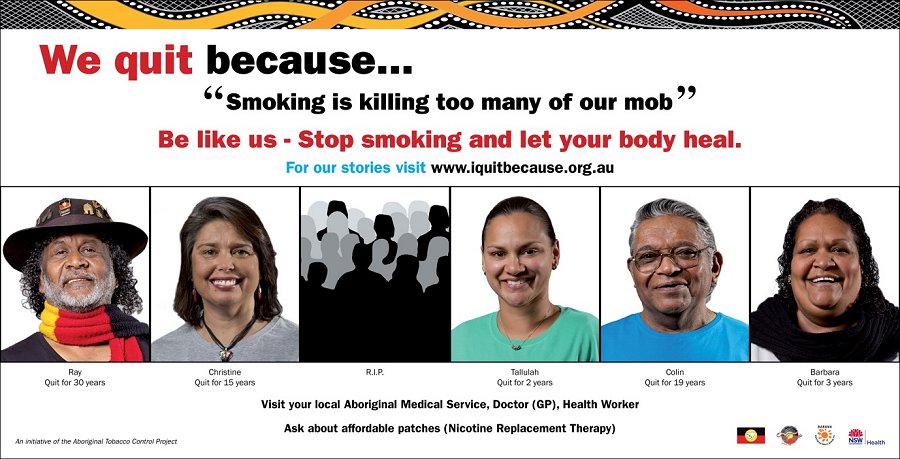
Strategies implemented as part of the project include:
- Social marketing including three advertising phases
- Culturally appropriate and localised resources
- Website http://www.iquitbecause.org.au/
- Facebook www.facebook.com/iquitbecause
- Promotion at community events including Yabun, NAIDOC, Close the Gap and World No Tobacco Day
- Community grants program
- Quit group programs
- Training and supporting staff to implement tobacco cessation brief advice.
Surveys of smoking prevalence, smoke free homes, knowledge and attitudes, intention to quit and preferred methods have been undertaken face-to-face at two Aboriginal Medical Services and community events across south west Sydney.
The project team are planning to conduct its final round of evaluation commencing late November 2014.
Remember to stop smoking and let your body heal.
www.iquitbecause.org.au or check out ![]() www.facebook.com/iquitbecause
www.facebook.com/iquitbecause
Further information contact: Natasha McEwan on 02 4640 3544 or email Natasha.McEwan@sswahs.nsw.gov.au
- Australian Institute of Health and Welfare 2010 National Drug Strategy Household Survey report. Drug statistics series no 25. Cat no. PHE 145. Canberra: AIHW 2011
- Australian Institute of Health and Welfare 2011 Substance use among Aboriginal and Torres Strait Islander people. Cat no. IHW 40. Canberra: AIHW 2011
- South Australian Department of Health. Indigenous Smoking Scoping Study: prepared for South Australian Department of Health. Adelaide (AUST): South Australia Department of Health; March 2008.
- Winstanley M, van der Sterren A, Knoche D. Tobacco use among Aboriginal peoples and Torres Strait Islanders. In: Scollo MM, Winstanley MH, editors. Tobacco in Australia: Facts and issues. 4th ed. Melbourne: Cancer Council Victoria; 2012. [cited 2014 Aug 15].
Close the Gap
Quit For New Life (QFNL)

What is Quit For New Life?
The Quit for new life program is a smoking cessation support initiative for pregnant and postnatal Aboriginal women. The program is an initiative of the Centre for Population Health, NSW Ministry of Health (MOH) in partnership with Kids and Families NSW.
The Quit for new life program aims to contribute to a reduction in tobacco related harm from maternal smoking and environmental tobacco smoke among women who identify as having an Aboriginal baby.
Smoking while pregnant contributes to an increased risk of a broad range of obstetric and infant complications, including pregnancy and labour complications, stillbirth, low birth weight and sudden infant death syndrome (SIDS). In addition to these risks from maternal smoking, exposure to environmental tobacco smoke is also a risk during pregnancy, and harms both the mother and foetus.
In 2011, the smoking prevalence among pregnant Aboriginal women in NSW was 52.2% compared with just 10% in non-Aboriginal pregnant women.
The NSW 2021 State Plan and NSW Tobacco Strategy 2012-2017 identifies women who smoke in pregnancy as a target group. The target is to reduce the rate of smoking by 2% per year for pregnant Aboriginal women and 0.5% for non-Aboriginal pregnant women.
The Health Promotion Service is working with the antenatal clinics, Aboriginal and Maternal Infant Health Services (AMIHS) and the Child & Family Health teams home visiting teams. The program is delivered as part of routine clinical practice as women attend antenatal and postnatal care.
The Quit for new life program comprises two key components: provision of cessation support strategies to women and their household members and practice change strategies for service providers.

Further information
Contact Natasha McEwan on 02 4640 3544 or email Natasha.McEwan@sswahs.nsw.gov.au
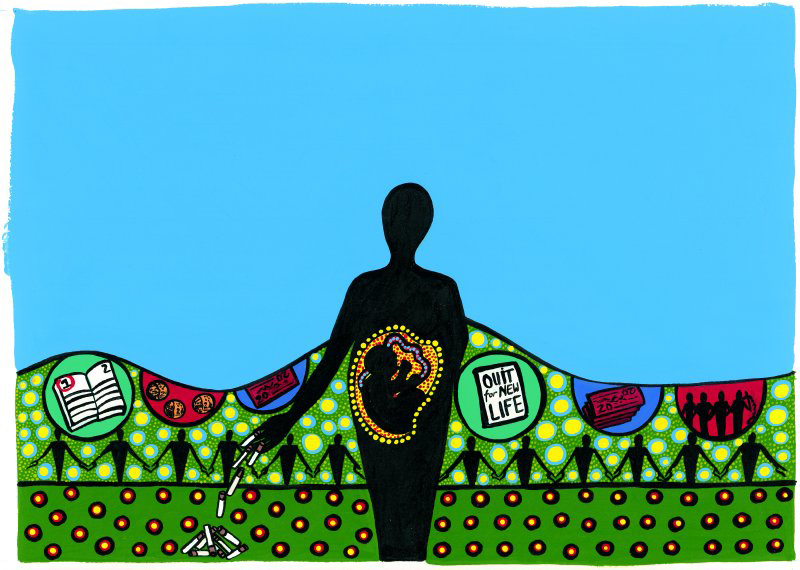
Close the Gap
Aboriginal Breastfeeding
The benefits of breastfeeding for both mothers and infants are well documented with exclusive breastfeeding recommended for the first six months of an infant's life.
However, only 52.5% of infants born to Aboriginal women in SWSLHD are fully breastfed on discharge from hospital (compared with 80% of infants in NSW). By two months of age, breastfeeding rates for Aboriginal infants in SWSLHD had also dropped rapidly to 26.3%.
Barriers and enablers to breastfeeding were discussed with Aboriginal services and organisations that support Aboriginal women in the SWSLHD. The findings revealed:
- Social and cultural influences significantly impact breastfeeding, "So coming from a cultural perspective, that's how it's been done for thousands of years. Over the last 200 or so years, that's changed enormously"
- Partners and maternal mothers have a great influence on a woman's decision to breastfeed. "I've seen with some of the girls that if their mum didn't breastfeed or if they don't have that family support or some have been brought up in foster care and they've lost that inter-generational support"
- Physical and environmental factors also impact on the ability to breastfeed.... "There's a stigma [of breastfeeding in public] and how the community makes you feel about breastfeeding your child when you could just pull a bottle out and that's more accepted than the more natural way".
Increasing breastfeeding rates in the Aboriginal community is a key priority for the Health Promotion Service and Aboriginal Services in SWSLHD. The Health Promotion Service is commencing the development of a culturally appropriate breastfeeding intervention.
Contact Danielle Weber on 02 8738 5825 or email Danielle.Weber@sswahs.nsw.gov.au

